by Sheila Dunning | Dec 14, 2017
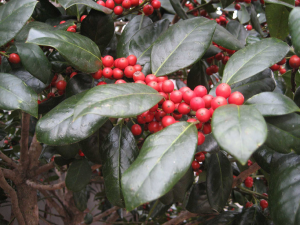 Photo by Sydney Park Brown UF/IFAS
Photo by Sydney Park Brown UF/IFAS
Holly has been considered sacred in some cultures because it remained green and strong with brightly colored red berries no matter how harsh the winter, even when most other plants would wilt and die. According to Druid lore, hanging the plant in homes would bring good luck and protection.
Later, Christians adopted the holly tradition from Druid practices and developed symbolism to reflect Christian beliefs. Today, the red berries are said to represent the blood that Jesus shed on the cross when he was crucified. Additionally, the pointed leaves of the holly symbolize the crown of thorns Jesus wore on his head.
Several holly species are native to Florida. Many more are cultivated varieties commonly used as landscape plants. Hollies (Ilex spp.) are generally low maintenance plants that come in a diversity of sizes, forms and textures, ranging from large trees to dwarf shrubs.
The berries provide a valuable winter food source for migratory birds; however, the berries only form on female plants. Hollies are dioecious plants, with male and female flowers on separate plants. Both male and female hollies produce small white blooms in the spring. Bees are the primary pollinators, carrying pollen from the male hollies 1.5 to 2 miles, so it is not necessary to have a male plant in the same landscape.
Several male hollies are grown for their compact formal shape and interesting new foliage color. Dwarf Yaupon Hollies (Ilex vomitoria ‘Shillings’ and ‘Bordeaux’) form symmetrical spheres without extensive pruning. ‘Bordeaux’ Yaupon has maroon-colored new growth. Neither cultivar has berries.
Hollies prefer to grow in partial shade but will do well in full sun if provided adequate irrigation. Most species prefer well-drained, slightly acidic soils. However, Dahoon holly (Ilex cassine) and Gallberry (Ilex glabra) naturally occur in wetland areas and can be planted on wetter sites.
For a more comprehensive list of holly varieties and their individual growth habits refer to ENH42 Hollies at a Glance: http://edis.ifas.ufl.edu/mg021

by Molly Jameson | Nov 27, 2017
 If you are a regular reader of Gardening in the Panhandle, you know that this e-newsletter covers many topics related to ornamental and vegetable gardening, Florida-friendly landscaping, pest management, and lawn and garden fertility.
If you are a regular reader of Gardening in the Panhandle, you know that this e-newsletter covers many topics related to ornamental and vegetable gardening, Florida-friendly landscaping, pest management, and lawn and garden fertility.
But did you also know that UF/IFAS Extension in the Florida Panhandle has four other E-newsletters covering topics such as Florida agriculture, wildlife and natural resources, 4-H youth, economic well-being, health and nutrition, and overall life quality for individuals and families?
These other E-Extension in the Panhandle newsletters include Panhandle Agriculture , Panhandle Outdoors, 4-H in the Panhandle, and Living Well in the Panhandle.
[notice]Additionally, UF/IFAS also has an extensive collection of publications on many of these e-newsletter topics. If you haven’t already, check out the Extension Data Information Source (EDIS) website. It is a comprehensive, single-source repository of all current UF/IFAS numbered peer-reviewed publications. Visit EDIS for a complete listing.[/notice]
As a Gardening in the Panhandle enthusiast, here is a list of horticulture and gardening related EDIS publications you might find useful:
Vegetable Gardening
Home Lawns and Landscapes
Soil and Fertility
Pest Management
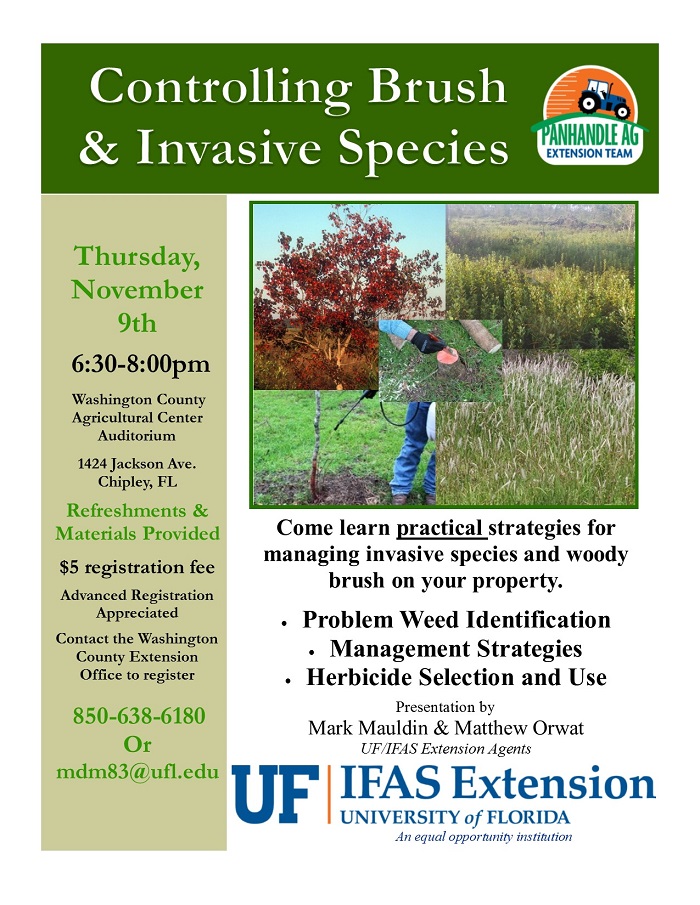
by Matthew Orwat | Oct 26, 2017
Encroaching brush, whether native or invasive, can be a problem for properties large and small. Fighting woody brush and other hard-to-kill weed species can be challenging for property owners. Many factors affect the effectiveness and efficiency of control efforts.
Timing of the application is a key factor that many property owners fail to consider. The cooler, fall and winter months are an excellent time to control a wide variety of troublesome brush species. With this in mind, the Washington County Extension Agents will be presenting a class, Controlling Brush & Invasive Species on November 9, 2017. The class will focus on plant identification and specific chemical control strategies that are effective in the fall and winter months. Herbicide selection and application techniques will be addressed in detail.
Controlling Brush & Invasive Species will be held at the Washington County Agricultural Center (1424 Jackson Ave., Chipley, FL) on Thursday, November 9, 2017 at 6:30 in the evening. Refreshments and printed reference materials will provided. There is a $5 registration fee for the class, payable at the door. Advanced registration for the class is appreciated. If you have questions or would like to register please contact Mark Mauldin at the Washington County Extension Office (850-638-6180 or mdm83@ufl.edu).

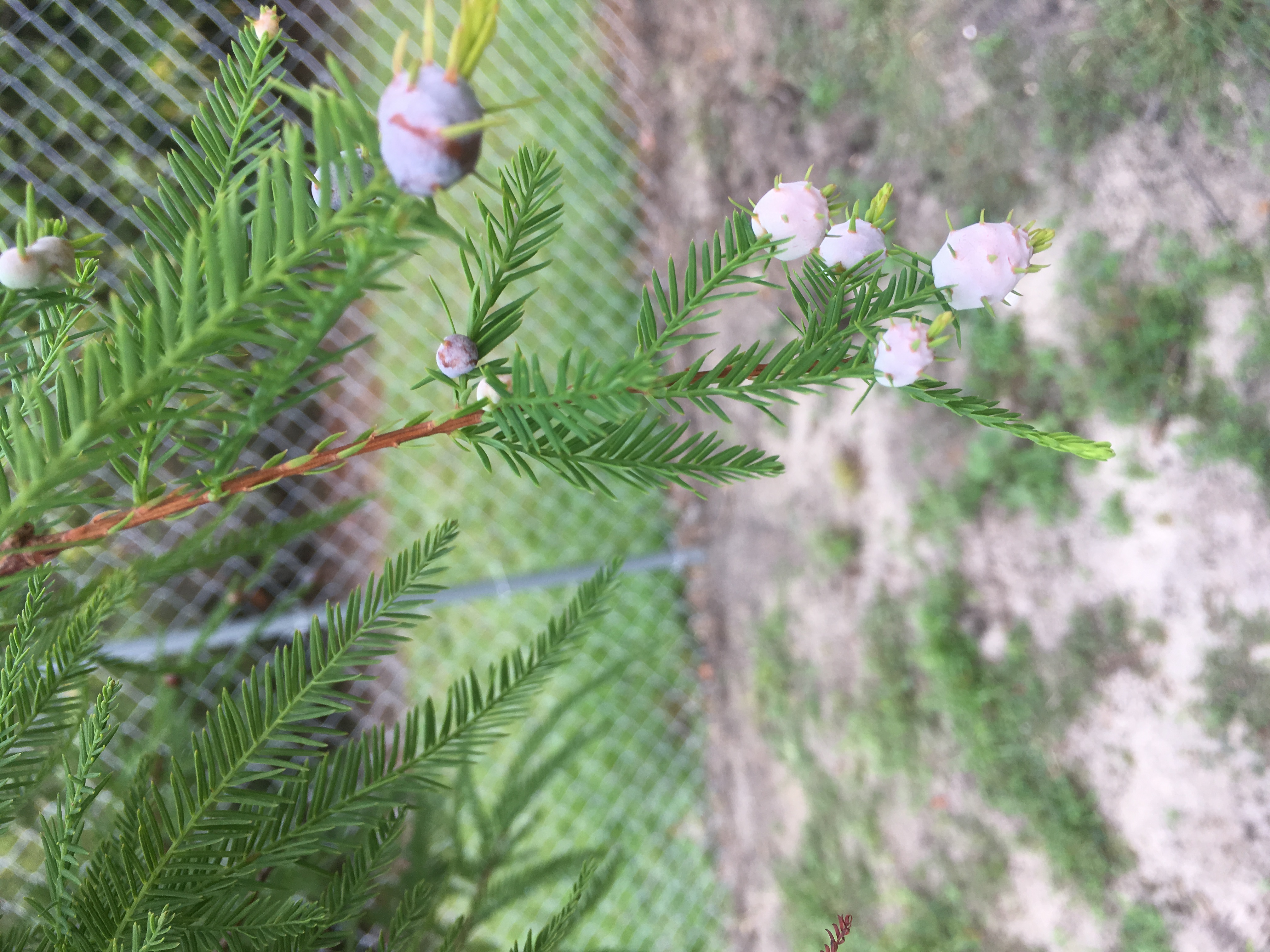
by Julie McConnell | Oct 23, 2017
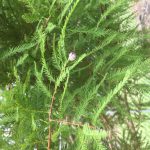
Cypress twig galls on bald cypress leaves. Photo: J_McConnell, UF/IFAS
Bald cypress Taxodium distichum is a native tree that is commonly planted in landscapes because it is adaptable to many sites and grows quickly. It is an interesting tree because it has soft flat leaves that fall off in the winter like other deciduous shade trees; however, it belongs to the Cypress family which consists mostly of needled evergreens.
Like the other cypresses, bald cypress produces cones in the fall, which is a primary means of reproduction for the species in natural settings. During the same season that cones are maturing, you might also see what looks like cones forming at the tips of branches among the leaflets rather than along the stem. These mysterious growths are not cones but rather twig galls.
Bald cypress twig galls are abnormal growths of leaf bud tissue triggered by the attack of the cypress twig gall midge Taxodiomyia cupressiananassa. In late spring, adult midges lay eggs on new leaves of the bald cypress. As the eggs hatch and midge larvae start feeding on the bald cypress leaves the growth of a twig gall is induced. The larvae take advantage of this gall using it for food and shelter throughout the larval stage and into the pupal stage. After pupation, adults emerge from the galls, mate, and females lay an average of 120 eggs over a two-day lifespan as an adult. This first generation lays eggs on mature leaves which starts the cycle again. The galls formed by the second generation of the year fall off and overwinter on the ground.
The galls do not appear to affect the health of trees overall, although the weight of heavily infested branches may cause drooping. There are many natural enemies of the twig cypress gall midge, so applying insecticides are not recommended since they may cause harm to non-target insects. The simplest management option is to collect and destroy the galls in the spring and fall to reduce populations the following season.
To read more about bald cypress trees or the twig gall please see the following publications:
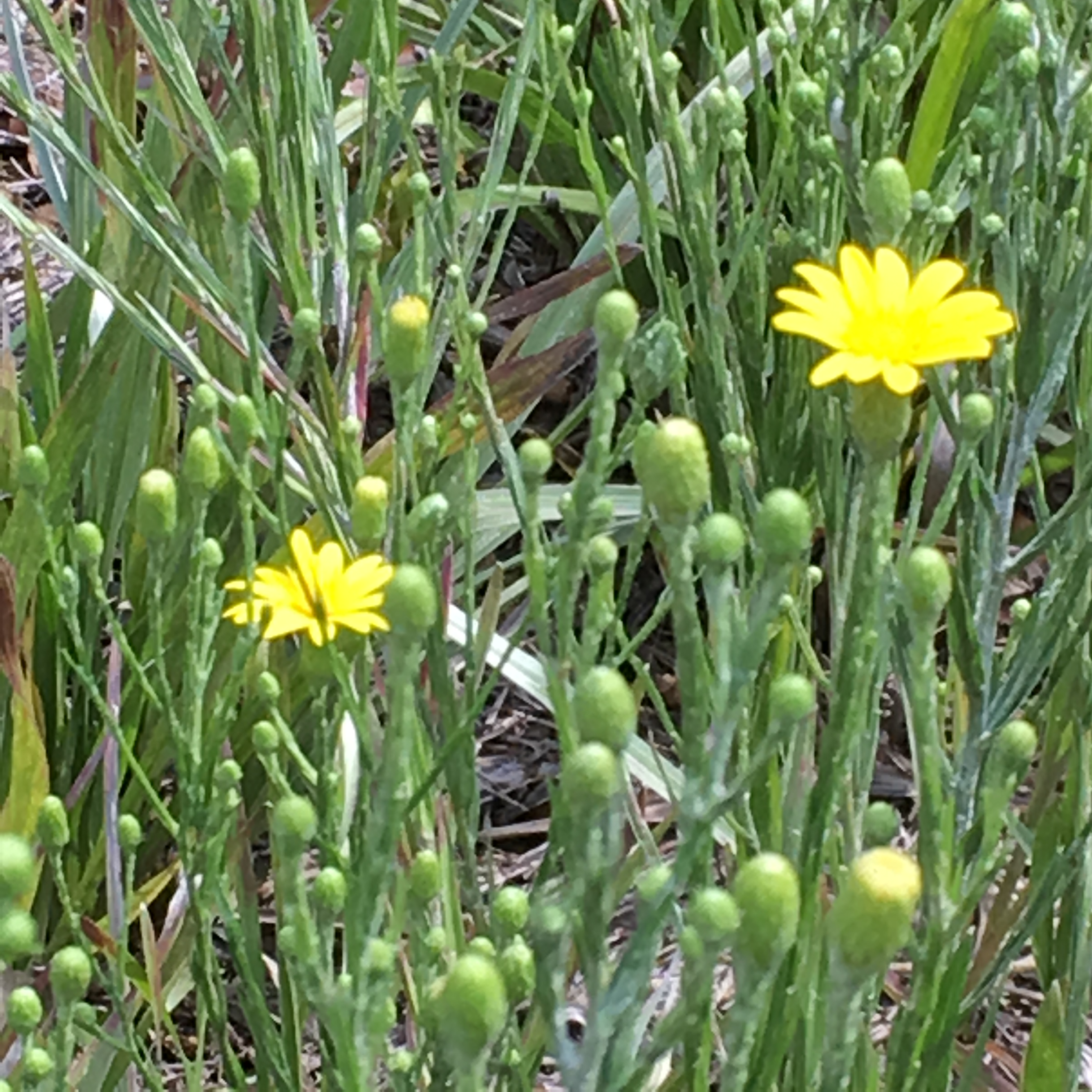
by Sheila Dunning | Oct 2, 2017
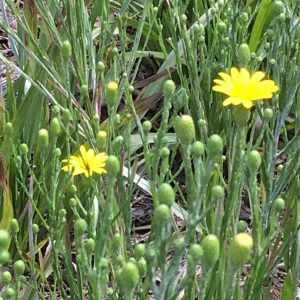
Silkgrass Pityopsis spp. Picture by: Sheila Dunning
Each fall, nature puts on a brilliant show of color throughout the United States. As the temperatures drop, autumn encourages the “leaf peepers” to hit the road in search of the red-, yellow- and orange-colored leaves of the northern deciduous trees.
Here in the Florida Panhandle, fall color means wildflowers. As one drives the roads it’s nearly impossible to not see the bright yellows in the ditches and along the wood’s edge. Golden Asters (Chrysopsis spp.), Tickseeds (Coreopsis spp.), Silkgrasses (Pityopsis spp.), Sunflowers (Helianthus spp.) and Goldenrods (Solidago spp.) are displaying their petals of gold at every turn. These wildflowers are all members of the Aster family, one of the largest plant families in the world. For most, envisioning an Aster means a flower that looks like a daisy. While many are daisy-like in structure, others lack the petals and appear more like cascading sprays.
So if you are one of the many “hitting the road in search of fall color”, head to open areas. For wildflowers, that means rural locations with limited homes and businesses. Forested areas and non-grazed pastures typically have showy displays, especially when a spring burn was performed earlier in the year.
With the drought we experienced, moist, low-lying areas will naturally be the best areas to view the many golden wildflowers. Visit the Florida Wildflower Foundation website, www.flawildflowers.org/bloom.php, to see both what’s in bloom and the locations of the state’s prime viewing areas.
And if you are want to add native wildflowers and other Florida-friendly plants to your landscape join the Master Gardeners for their Fall Plant Sale to be held Saturday, October 14 from 8 am to noon at the Okaloosa County Extension Annex located at 127 SW Hollywood Blvd, Ft. Walton Beach.
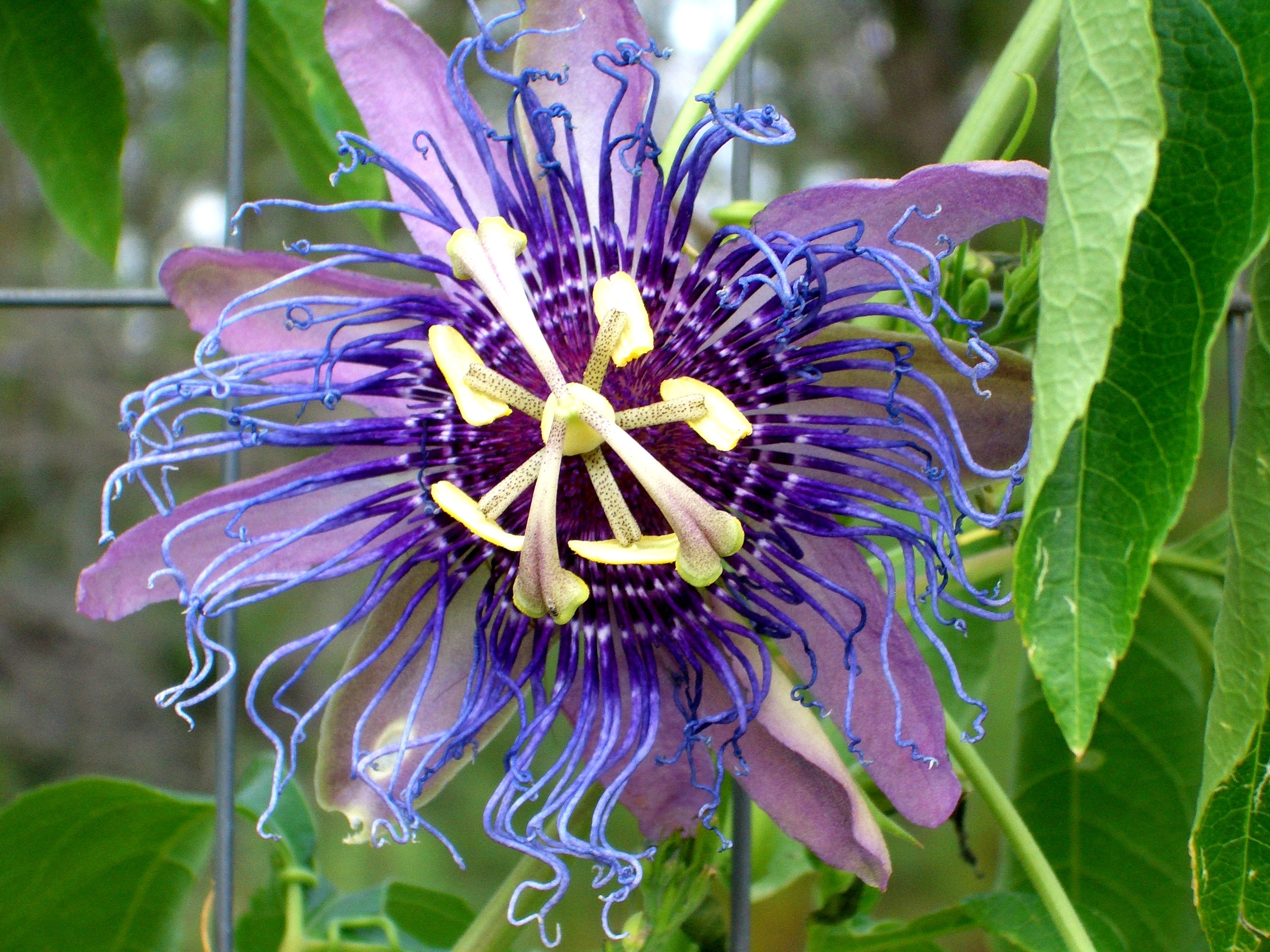
by Carrie Stevenson | Aug 11, 2017
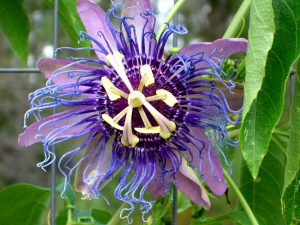
The passionflower vine is beautiful and attracts butterflies, but can also be used for food and sedation drugs. Photo credit: Dorothy Birch
Ethnobotany lies at the intersection of culture, medicine, and mythology. The “witch doctors” and voodoo practitioners, the followers of the Afro-Cuban religion of Santeria, and the wise elders of ancient Chinese civilizations are all ethnobotanists. So, too, are the modern day field biologists who discover and develop medicinal plants into an estimated half of our pharmaceutical drugs. Simply put, ethnobotany is the study of how people and cultures (ethno) interact with plants (botany).
For tens of thousands of years, humans have been learning about plants’ chemical, nutritious, and even poisonous properties. Plants evolve these properties to defend themselves against pathogens, fungi, animals and other plants. Other properties, like color, scent, or sugar content may attract beneficial species. Humans most likely started paying attention to plant characteristics to decide whether to eat them. From there, one can imagine people started using plants to build structures or use fiber for ropes, baskets, and clothing.
My first experience with the idea of ethnobotany was as a college student on a study tour of Belize. A professional ethnobotanist took us on a tour of the Maya Rainforest Medicine Trail, pointing out dozens of native trees, shrubs, and grasses used for medicinal and cultural purposes by local tribes. From birth control and pain relief to chewing gum and pesticides, the forest provided nearly everything Central American civilizations needed to survive for thousands of years and into the present. The tour captured my imagination as I considered the possibilities yet undiscovered in the deep rainforests worldwide.
Of course, there is no need to travel out of the country, or even the state, to learn about useful native plants. One of my favorite publications put out by UF IFAS Extension specialists is “50 Common Native Plants Important in Florida’s Ethnobotanical History.” Another fascinating source of information about historic, cultural, and even murderous uses of plants is Amy Stewart’s Wicked Plants: The Weed That Killed Lincoln’s Mother and Other Botanical Atrocities. Plants with interesting historical uses make for great stories along a trail, and help create a connection between the casual observer and the natural world around them.
A handful of interesting native plants with significant medicinal properties include the cancer-fighting plants saw palmetto (Serenoa repens) and mayapple (Podophyllum peltatum). Saw palmetto berries are used for prostate cancer treatment, while the $350+ million annual Florida mayapple harvest helps produce chemotherapy drugs for several types of cancer. The carnivorous bog plant, pink sundew (Drosera capaillaris) uses enzymes to break down insect protein, and Native American tribes used the plant for bacterial and fungal skin disorders.
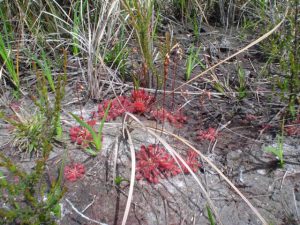
Sundews, tiny carnivorous plants found in pitcher plant bogs, use an enzyme to dissolve insect proteins. Native Americans recognized this property and used the plant for skin maladies. Photo credit: Carrie Stevenson, UF IFAS Extension
Many plants had (and still have) multiple uses. Yaupon holly (Ilex vomitoria) leaves brewed as a highly caffeinated tea were used ceremonially and before warfare by many southeastern American Indian tribes, and then later by early American settlers when tea was difficult to import. Holly branches were used for arrows, and the bark for warding off nightmares. The purple passionflower, or maypop (Passiflora incarnata) vine attracts butterflies and produces a pulp used for syrups, jams, and drinks. Passionflower extract has also been developed into dozens of drugs and supplements for sedation.
Early civilizations living closer to the land knew many secrets that modern medicine has yet to unlock. Thanks to the ethnobotanists, the field and forest will continue to heal and provide for us for many generations yet to come.
CAUTION: Many of the plants listed or referenced can have hazardous or poisonous properties without appropriate preparation or dosage. Allergic reactions and prescribed drug interactions may occur, and many unproven rumors exist about medicinal uses of plants. Always consult a physician or health professional before trying supplements.
 Photo by Sydney Park Brown UF/IFAS
Photo by Sydney Park Brown UF/IFAS








